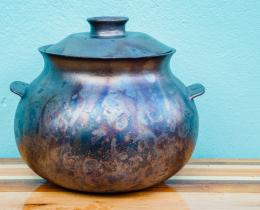It seems like nearly everything today is digital. For many people, listening to music, watching movies and television, or reading the news takes place solely on digital devices, and often all on the same device. Creating art—photography especially—is often done digitally and shared solely online.
Set against the backdrop of this pixelated world is a revived interest in creating things by hand. Botanical illustration is a great case in point.
Botanical illustrator Wendy Hollender explains, “The botanical illustrator can show things a photograph can’t. The act of studying and drawing nature close up allows the artist to really see something in a way that you can’t if you just click a photograph. It’s the ability to observe closely, to touch, to feel, to see, to draw, that connects a person with nature in a really valuable way.”
A sense of connection can be easier to experience when working with your hands and physical materials than when using a trackpad, mouse, digital stylus, or computer. Taking time to hand craft something requires attention and concentration, qualities typically associated with meditation.
“The process I use is incredibly relaxing and meditative. Putting that together with the close study of a plant creates an all-encompassing experience,” Hollender says. “You’re really slowing down, studying bits of detail in a way you don’t really get a chance to see otherwise.”
Record-Breaking Kickstarter Campaign
Hollender joined forces with herbalist and wildcrafter Dina Falconi to create a book of botanical illustrations that was that was part cookbook, part herbal, part botanical record. A labor of love that took years to create, they decided to self-publish, and in late 2013 launched a Kickstarter campaign for Foraging & Feasting: A Field Guide and Wild Food Cookbook.
By the time the campaign ended in March 2014, they had raised slightly more than $115,000 from 2,315 backers, making it the first cookbook to raise more than $100,000 on Kickstarter. In the first year they sold more than 8,000 copies of the book without using a major distributor.
The success of their project is a reflection not just of the growing interest in local food, but also of a respect for handcrafted things and a desire to connect to the natural world.
Plant Identification in Perennial Demand
Today botanical illustration serves essentially the same purpose it has for hundreds of years. “Originally, the function of botanical illustration was plant identification and description, so that somebody like an early monk, who might use a plant for medicinal purposes, would know what the plant looked like, how to find it, and how to gather it,” says Hollender.
This is exactly how Foraging & Feasting is intended to be used. Author Dina Falconi says the book “is designed for someone looking in their backyard, or wherever they live, to find food there. People can visually begin to identify what they are seeing. Then they can learn the ethnobotany. Can you eat it? Is it medicine? How has it been used historically? What does it smell like, taste like?”
In doing so, users of the book are connecting with an age-old practice, enriching their life in a practical way, and contemplating the natural world, all at the same time.



